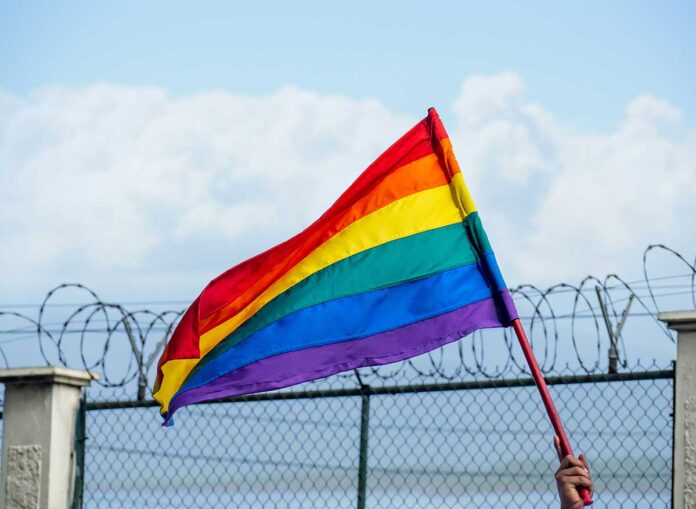Martin Luther King Day is a day of reflection and service for me. I live in one of Philadelphia’s poorest Black neighborhoods. Mine is one of few white families living here, on the demarcation line between lower Germantown and Nicetown. It is not far from where I grew up, but it is not a safe place to live, and the tree-lined streets belie the conflicts that poverty and drugs, gangs and violence breed for everyone here.
No one thinks about queer and trans people here, so far outside the Gayborhood. Only a half hour away by car, but light years from affluence and privilege. Here we have no banks, no shops that aren’t discount stores, no white tablecloth restaurants — just take-out places with bullet-proof windows. The nearby school ranks 1 on a scale of 1 to 10 academically.
And while gunfire isn’t as common as it used to be, three Black men have been shot to death right outside our house in the past six years and there are bullet holes in two of the first floor windows. The city just designated our neighborhood as one of three high-crime areas in need of extra police protection.
These facts of where I live and with whom frame my perspective on race. Zipcodes are everything and it’s always presumed that LGBTQ people don’t live in zipcodes like mine. And despite a very different reality, it is also often presumed by straight society that LGBTQ people are mostly white.
Being conscious of racial inequities was inculcated early for me. My parents were Civil Rights workers and co-founders of the Philadelphia to Philadelphia Project, an interracial group that operated between Philadelphia, Pennsylvania and Philadelphia, Mississippi. I learned activism from watching my parents and the Black men and women activists who came in and out of our home. I also learned about racial justice and lack thereof.
I was too young then to understand the importance of meeting those people from SNCC (Student Nonviolent Coordinating Committee) and CORE (Congress of Racial Equality) who were my parents’ friends and colleagues. I didn’t even understand that other white children were kept largely segregated from Black people. I would learn.
So for me, Martin Luther King Day is a somber holiday. It’s a day of reflection as well as a day of personal memories, and a day when we should all be contemplating — particularly those of us who are white — what it is we can do to make our city and our community a more equitable place. There has been a lot of lip-service to racial equity in Philadelphia over the years I’ve lived here. Some pretty grim facts remain: Philadelphia is the poorest big city in America and it is also nearly three-quarters people of color. Those things are inextricably linked.
Many politicians have claimed to have answers — 10 Democrats making those claims are running for mayor right now — but the pesky facts of poverty, lack of access, and race remain deeply entrenched. And embedded within are LGBTQ people of color in neighborhoods like mine who have been largely ignored. In my recent series on LGBTQ elderly, I interviewed a number of Black and Latinx elders in my neighborhood, North Philly and Mount Airy. Their experiences are so divergent from those of white Center City Gayborhood residents. As a doctor from SAGE (Services & Advocacy for GLBT Elders) told me, we need more housing for LGBTQ people in the neighborhoods to prevent elder homelessness, and we need more understanding that LGBTQ people live mostly outside the Gayborhood.
In his Nobel Peace Prize address in 1964, Dr. King said, “There is nothing new about poverty. What is new, however, is that we have the resources to get rid of it.”
How do we create these necessary changes?
James Baldwin said, “I can’t believe what you say, because I see what you do.” Those words still ring true some 60 years after Baldwin first wrote them.
Baldwin is an appropriate companion read to Dr. King as we contemplate what activism is, particularly with regard to the fraught history of racial conflicts in our own queer and trans communities. I have written extensively about the financial inequities of being a Black or brown queer or trans person. Many of the people I have interviewed for my series on LGBTQ poverty and LGBTQ homelessness have been Black.
Last year my award-winning series on LBT women in prison highlighted how disproportionate the numbers of queer women in prison are and also how disproportionate the racial component of those demographics are. I have also written about the violence against Black and brown trans women and gender nonconforming lesbians. I have detailed how corrective rape remains a tool of violence against predominately Black lesbians.
Highlighting these inequities is a first step. But what comes next? This is the question facing us as a community. What are we doing to stem the poverty that often leads to LGBTQ people — particularly trans women of color and lesbians of color — becoming victims of violence and hate crimes? What do we do to connect queer and trans people in neighborhoods like mine with affluent LGBTQ folks in Center City, Society Hill and Old City? What is our goal as a community toward racial healing and racial, gender and LGBTQ equity.
In “Letter from a Birmingham City Jail,” Dr. King wrote, “Injustice anywhere is a threat to justice everywhere.”
Recognizing injustices in our own community is not an easy task, whether they be based on race, economics, sexual orientation or gender identity. Recognizing how we are obligated to work to eradicate it may be harder still. But essential to our community and all its members.

